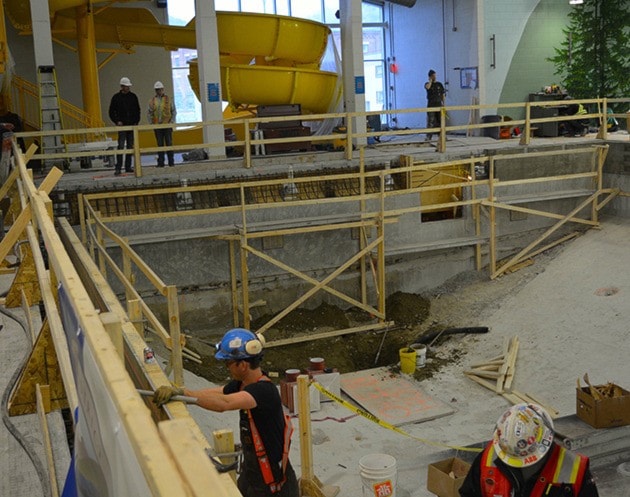When it reopens in September, the pool at the Nelson and District Community Complex will smell less of chlorine than before.
That’s not because it will be using less of it, but because a powerful new air circulation method — a trichloramine exhaust system — will suck out the evaporated chlorine.
“We will have twice the air movement in the pool,” says operations supervisor Jason Craig. “This will be a much improved environment. The nastier off-gassed chlorine levels are always in the first couple of feet above the water, so we will have a venting system that will draw the air across the top of the pool and take away the trichloramines [evaporated used chlorine].”
It’s the trichloramines — the off-gassed chlorine by-product that has already done its job of disinfecting the water — that causes the typical pool smell, he says.
“You go to some hotels and you can smell their pool from outside the building. That’s because they have not kept their used chlorine levels in check and are not able to dispose of the evaporated chlorine.”
The renovated Nelson pool will disinfect the water with a combination of chlorine and ultraviolet light (UV). BC’s Public Health Act requires the use of chlorine in all public pools, at a minimum of 0.5 parts per million.
But the new pool will exceed that minimum. The amount is still in the planning stages but it might contain up to two parts per million. Craig says a boost from the basic 0.5 is required every time contamination (stool or vomit) is detected in the pool and this happens often enough that it makes sense to keep the chlorine at a higher level continuously.
“With all the studies we have read,” he says, “we know if we have contamination you have to go to two parts per million. The time it takes to raise it to two parts per million in the affected area, and the health risks to our staff from the contaminants themselves to get it up to two parts per million, are not worth it. Studies show that two parts per million in a pool kills every bug on contact, except giardia which takes 15 minutes.”
Chlorine levels in the hot tub, which Craig describes as “a perfect breeding ground for bugs due to the temperature,” are kept at three to 3.5 parts per million.
There are some public misconceptions about chlorine and pool disinfection, says Joe Chirico, the RDCK’s manager of community services.
“People think we should just use ozone as a primary treatment, and that it means we won’t use chlorine,” he says. “That is not true.”
At the new Nelson pool, ozone won’t be used at all.
Ozone is a better disinfectant than chlorine, Craig says, but it has a weakness: it doesn’t really want to be ozone. It’s oxygen with a third atom that wants to attach to other molecules including chlorine, so you end up using more chlorine and losing ozone. In the past, ozone was a secondary treatment in the Nelson pool but that will be discontinued in the new pool.
“When we had ozone the net result was we were using more chlorine because ozone destroys it. Ozone does not provide a true benefit because the infrastructure you need to see the full benefit is expensive and requires costly maintenance.”
In any event, entirely replacing chlorine with ozone is not in the cards because of the provincial government requirement that all pools must use chlorine.
The pool will rely on UV as a secondary treatment.
“UV does not do the same thing as chlorine,” says Craig. “Chlorine attaches to organics and destroys them through oxidation. UV goes to the cellular level and kills the virus at the DNA level.”
Water is circulated in and out of the pool so that the entire pool is filtered every six hours. During the recirculation process, on its way back into the pool, water is subjected to UV, which acts instantaneously.
Craig says chlorine and UV complement each other because chlorine has the advantage of being in the water all the time, whereas UV can only affect it momentarily as the water flows back into the pool. He says the possibility of contaminants in the pool means a disinfectant (chlorine) has to be in the water permanently.
